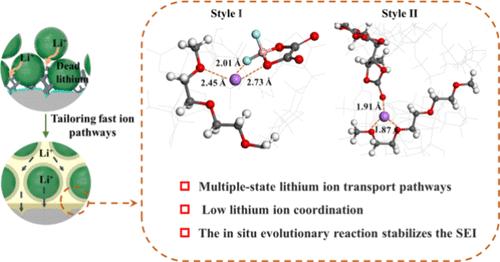具有限域离子传输途径的石榴石/聚合物复合薄膜电解质的高性能固态锂金属电池
IF 15.8
1区 材料科学
Q1 CHEMISTRY, MULTIDISCIPLINARY
引用次数: 0
摘要
界面工程和复合电解质的综合方法对于锂金属电池(LMB)的市场应用至关重要。本研究设计了一种 22 μm 薄膜型聚合物/Li6.4La3Zr1.4Ta0.6O12(LLZTO)复合固态电解质(LPCE),该电解质兼具快速离子传导和稳定的界面演化特性,可提高锂金属界面的稳定性和循环性能。由三乙二醇二甲醚(TGDE)和阴离子形成的醚基分子配位基团/簇促进了 Li+ 在聚合物链段之间的移动。这些特定的配位簇极大地 "限制 "了阴离子与 Li+ 之间的相互作用,促使阴离子跟随配位簇到达金属锂处,优先参与固态电解质界面(SEI)衍生。富含无机盐的梯度 SEI 调节了 Li+ 的沉积,抑制了枝晶的失控生长,使锂离子对称电池在 0.2 mA cm-2 的条件下稳定循环超过 2000 小时。这项工作证明了限域离子群在离子传输和界面演化中的重要性,为固态 LMB 提供了一个视角。本文章由计算机程序翻译,如有差异,请以英文原文为准。

High-Performance Solid-State Lithium Metal Batteries of Garnet/Polymer Composite Thin-Film Electrolyte with Domain-Limited Ion Transport Pathways
The integrated approach of interfacial engineering and composite electrolytes is crucial for the market application of Li metal batteries (LMBs). A 22 μm thin-film type polymer/Li6.4La3Zr1.4Ta0.6O12 (LLZTO) composite solid-state electrolyte (LPCE) was designed that combines fast ion conduction and stable interfacial evolution, enhancing lithium metal interface stability and cycling performance. The ether-based molecular coordination groups/clusters formed by triethylene glycol dimethyl ether (TGDE) and anions facilitated the movement of Li+ between the polymer chain segments. These specific coordination clusters significantly “constrained” the interaction between anions and Li+, inducing the anions to follow the clusters to the Li metal and preferentially participate in solid electrolyte interface (SEI) derivatization. The inorganic salt-rich gradient SEI modulates Li+ deposition and inhibits uncontrolled dendrite growth, achieving stable cycling of Li symmetric cell at 0.2 mA cm–2 for over 2000 h. Furthermore, the Li||NCM811 cell at a rate of 0.1 C exhibits an initial discharge capacity of 194.5 mAh g–1, maintaining a capacity retention rate of over 90% after 500 cycles. This work demonstrates the importance of domain-limited ion clusters in ion transport and interfacial evolution, providing a perspective for solid-state LMBs.
求助全文
通过发布文献求助,成功后即可免费获取论文全文。
去求助
来源期刊

ACS Nano
工程技术-材料科学:综合
CiteScore
26.00
自引率
4.10%
发文量
1627
审稿时长
1.7 months
期刊介绍:
ACS Nano, published monthly, serves as an international forum for comprehensive articles on nanoscience and nanotechnology research at the intersections of chemistry, biology, materials science, physics, and engineering. The journal fosters communication among scientists in these communities, facilitating collaboration, new research opportunities, and advancements through discoveries. ACS Nano covers synthesis, assembly, characterization, theory, and simulation of nanostructures, nanobiotechnology, nanofabrication, methods and tools for nanoscience and nanotechnology, and self- and directed-assembly. Alongside original research articles, it offers thorough reviews, perspectives on cutting-edge research, and discussions envisioning the future of nanoscience and nanotechnology.
 求助内容:
求助内容: 应助结果提醒方式:
应助结果提醒方式:


